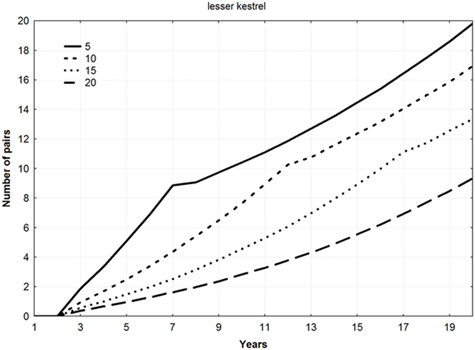Reintroductions have been increasingly used for species restoration and it seems that this conservation tool is going to be more used in the future. Nevertheless, there is not a clear consensus about the better procedure for that, consequently a better knowledge of how to optimize this kind of management is needed. Here the dynamics of released long-lived bird populations (lesser kestrel, Falco naumanni, Bonelli's eagle Aquila fasciata, and bearded vulture Gypaetus barbatus) in object-oriented simulated reintroduction programs is examined. To do that, number of young per year and number of years of released necessary to achieve a successful reintroduced population were calculated. A successful reintroduction is defined as one in which when the probability of extinction during two times the maximum live-span period for the species (20, 50, and 64 years respectively) was less than 0.001 (P<0.001) and they showed a positive trend in population size (r>0.00). Results showed that a similar total number of young must be released in all the species in all the scenarios in order to get a successful reintroduction. Consequently, as more young per year are released the new population is going to be larger at the end of the simulations, the lesser the negative effects in the donor population and the lowest the total budget needed will be. Morandini and Ferrer (2017) How to plan reintroductions of long-lived birds. PLoS ONE 12(4) e0174186 https://doi.org/10.1371/journal.pone.0174186
http://journals.plos.org/plosone/article?id=10.1371/journal.pone.0174186

 Las altas temperaturas están provocando que las lagunas y las marismas de Doñana pierdan agua rápidamente
Las altas temperaturas están provocando que las lagunas y las marismas de Doñana pierdan agua rápidamente




